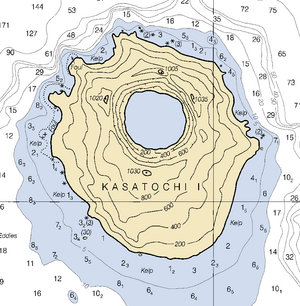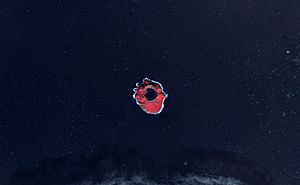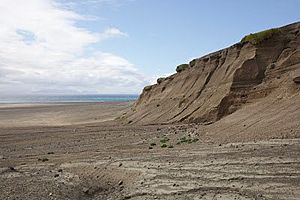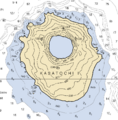Kasatochi Island facts for kids
Quick facts for kids Kasatochi Island |
|
|---|---|
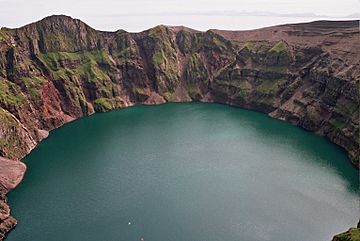
Kasatochi volcano with crater lake before the eruption of August 7, 2008
|
|
| Highest point | |
| Elevation | 1,030 ft (310 m) |
| Prominence | 1,030 ft (310 m) |
| Geography | |
| Location | Aleutian Islands, Alaska, United States |
| Topo map | USGS Atka C-5 |
| Geology | |
| Volcanic arc/belt | Aleutian Arc |
| Last eruption | August 2008 |
Kasatochi Island (Aleut: Qanan-tanax̂; Russian: Касаточий остров) is an active stratovolcano, which is a tall, cone-shaped volcano. It is also known as Kasatochi volcano. This island is part of the Aleutian Islands in southwestern Alaska.
Contents
Where is Kasatochi Island?
Kasatochi Island is one of the Aleutian Islands. These islands sit on a narrow ridge. This ridge separates the Bering Sea from the Pacific Ocean. Kasatochi is located near Atka Island and Great Sitkin Island.
The island is about 5.051 square kilometers (1.9503 sq mi) in size. Its highest point is 314 meters (1,030 feet) above sea level. No people live on Kasatochi Island permanently.
Life on Kasatochi Before 2008
Before 2008, Kasatochi Island was a special place. It had a unique landscape. This made it a perfect home for many plants and animals.
Island Shape and Features
The island was about 3 kilometers (1.9 miles) wide. It was steepest on its northern side. Near the center was a deep, bowl-shaped caldera. This caldera held a lake. The lake's surface was only about 60 meters (200 feet) above sea level. The island also had steep cliffs and small, rocky beaches. These different areas provided many types of homes for wildlife.
Plants and Greenery
Before the 2008 eruption, most of Kasatochi Island was covered in plants. Only the crater walls and sea cliffs were bare. Thick grasses and other plants grew everywhere else. This green landscape was home to many unique species. The coastal areas also had lots of plant life. This included different types of sea grasses, kelp, and corals.
Animals and Birds
Kasatochi Island was famous for its many seabirds. It also had birds of prey and sea animals. Ocean currents and the island's shape created perfect conditions for them.
The island was different from many other Aleutian islands. It had a huge number of seabirds. More than 100,000 crested auklets and 150,000 least auklets lived there. This was one of the largest colonies in the Aleutian chain. Other seabirds included the Fork-tailed petrel and the whiskered auklet. These birds attracted predators like bald eagles and peregrine falcons. Birds were the main animals on the island. They connected the land and sea ecosystems.
Many insects, spiders, and fish also lived on the island. The large number of fish helped feed the auklets. The island was also home to an endangered Steller sea lion rookery. A rookery is a place where animals gather to breed. About 1,000 Steller sea lions lived there before the 2008 eruption.
The August 2008 Eruption
Before 2008, scientists didn't know much about Kasatochi's eruption history. There were no monitoring devices on the island. So, predicting the eruption was very difficult. It happened suddenly and without much warning.
On August 7, 2008, Kasatochi volcano exploded. It sent a huge cloud of ash high into the sky. The ash plume reached up to 13,700 meters (45,000 feet). The eruption lasted for 24 hours. It included several powerful blasts. Hot flows of ash and gas, called pyroclastic flows, covered most of the island. These deposits were many meters thick. The last confirmed activity on Kasatochi was in 1899.
The eruption affected many people. Two biologists from the U.S. Fish and Wildlife Service were on the island. They had to evacuate quickly. Their research stopped, but new research began later. Nearby islands were also affected. Adak Island, which had about 300 people, received up to 6 centimeters (2.4 inches) of ash. Luckily, no one was killed or injured immediately.
Life on Kasatochi After 2008
Changes to the Island's Shape
The eruption completely changed Kasatochi's landscape. Beaches, forests, and soil were buried under meters of ash and volcanic rock. The island's total area grew by about 40%. The crater also got bigger. Its rim dropped by about 60 meters (200 feet). The lake inside the crater became much smaller. However, streams slowly refilled it. The coastline expanded by hundreds of meters. This destroyed much of the marine habitat near the island's edge.
Plants and Greenery After the Eruption
All visible life on the island seemed to be gone after the eruption. The hot pyroclastic flows and volcanic ash buried the entire island. Even the soil became almost useless. Most land plants, like grasses and trees, were destroyed by the heat. Then they were covered. This made it very hard for new plants to grow. Many bird nesting sites and sea lion rookeries were buried too. Important underwater kelp beds were also covered by the new volcanic deposits.
Animals and Birds After the Eruption
Right after the eruption, scientists thought no animals had survived. Organisms either died or fled as their homes were destroyed. Most marine and bird breeding areas were covered by ash. This included the endangered Steller sea lion rookery.
But surprisingly, animals started to return. Sea lions were seen on the island just two weeks after the eruption. Their rookeries were buried, but coastal erosion cleared them by 2009. About 200,000 auklets returned in the summer of 2009. However, they couldn't nest because their sites were still covered in ash.
Because of this huge natural disaster, Kasatochi became a perfect place to study primary succession. This is how life returns to an area where everything was destroyed. Scientists started a research project in 2009. They wanted to study how the ecosystem recovered over time. This was a rare chance to learn about how life rebuilds after such a big event.
Research on Recovery
Why Study Kasatochi?
Before the eruption, Kasatochi Island was part of the Alaska Maritime National Wildlife Refuge. Scientists had studied birds and mammals there since 1996. They learned a lot about the island's ecosystem before the disaster.
The 2008 eruption destroyed almost all life on Kasatochi. This was similar to other volcanic eruptions, like Surtsey in Iceland or Mount St. Helens in the United States. But Kasatochi offered a special chance to study how species return. This is because scientists had so much information about the island *before* the eruption. By understanding Kasatochi, they hoped to learn how to help other places recover from similar disasters.
What Scientists Observed
In 2008, a team of researchers visited the island. They wanted to see the immediate effects of the eruption. They studied how the eruption impacted soils, water, plants, birds, insects, and marine life. Their goal was to find patterns in how each species returned. They also wanted to see if these patterns were connected.
Scientists noticed many interesting things. Erosion played a big role in the island's recovery. As wind and water wore away the new volcanic deposits, old soil was uncovered. In these rare spots, new plants began to grow. This allowed birds to return and find nesting sites.
Another surprising discovery was "legacies." These are parts of the old ecosystem that survived the eruption. Scientists thought everything would be destroyed. But some insects, for example, were survivors or their offspring.
How species spread to the island was also important. This is called dispersal. Many new plants and animals arrived by wind, flight, or water. However, most of them struggled to find suitable homes. So, while new species kept arriving, many did not survive. More species will thrive when the island's environment becomes more stable.
By studying Kasatochi, scientists are learning a lot. They are understanding how land and sea ecosystems interact. They are also gaining new knowledge about how ecosystems rebuild after a major natural disaster.
Images for kids



